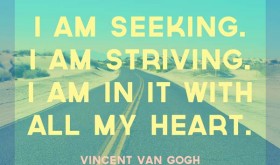Funny Motivational Quotes Biography
Source Google.com.pk
Flow is the mental state of operation in which a person performing an activity is fully immersed in a feeling of energized focus, full involvement, and enjoyment in the process of the activity. In essence, flow is characterized by complete absorption in what one does. Proposed by Mihály Csíkszentmihályi, this positive psychology concept has been widely referenced across a variety of fields.[1]
According to Csikszentmihalyi, flow is completely focused motivation. It is a single-minded immersion and represents perhaps the ultimate experience in harnessing the emotions in the service of performing and learning. In flow, the emotions are not just contained and channeled, but positive, energized, and aligned with the task at hand. The hallmark of flow is a feeling of spontaneous joy, even rapture, while performing a task[2] although flow is also described (below) as a deep focus on nothing but the activity – not even oneself or one's emotions.
Flow has many of the same characteristics as (the positive aspects of) hyperfocus. However, hyperfocus is not always described in such universally glowing terms. For examples, some cases of spending "too much" time playing video games, or of getting side-tracked and pleasurably absorbed by one aspect of an assignment or task to the detriment of the assignment in general. In some cases, hyperfocus can "grab" a person, perhaps causing him or her to appear unfocused or to start several projects, but complete few.
Mihaly Csikszentmihalyi and his fellow researchers began researching flow after Csikszentmihalyi became fascinated by artists who would essentially get lost in their work. Artists, especially painters, got so immersed in their work that they would disregard their need for food, water and even sleep. Thus, the origin of research on the theory of flow came about when Csikszentmihalyi tried to understand this phenomenon experienced by these artists. Flow research became prevalent in the 1980s and 1990s, with Csikszentmihalyi and his colleagues in Italy still at the forefront. Researchers interested in optimal experiences and emphasizing positive experiences, especially in places such as schools and the business world, also began studying the theory of flow at this time. The theory of flow was greatly used in the theories of Maslow and Rogers in their development of the humanistic tradition of psychology.[3] Flow has been experienced throughout history and across cultures. The teachings of Buddhism and Taoism speak of a state of mind known as the "action of inaction" or "doing without doing" that greatly resembles the idea of flow. Also, Hindu texts on Advaita philosophy such as Ashtavakra Gita and the Yoga of Knowledge such as Bhagavad-Gita refer to a similar state.
Historical sources hint that Michelangelo may have painted the ceiling of the Vatican's Sistine Chapel while in a flow state. It is reported that he painted for days at a time, and he was so absorbed in his work that he did not even stop for food or sleep until he reached the point of passing out. After this, he would wake up refreshed and, upon starting to paint again, re-enter a state of complete absorption.
Bruce Lee either spoke of a psychological state similar to flow or spoke about the importance of adaptability and shedding preconceptions in his book the Tao of Jeet Kune Do. In his book, he compares the state of flow to water where he so famously says, “Be like water ...Empty your mind, be formless. Shapeless, like water. If you put water into a cup, it becomes the cup. You put water into a bottle and it becomes the bottle. You put it in a teapot, it becomes the teapot. Now, water can flow or it can crash. Be water, my friend."[5]
In every given moment, there is a great deal of information made available to each individual. Psychologists have found that one's mind can attend to only a certain amount of information at a time. According to Mihaly's 1956 study, that number is about 126 bits of information per second. That may seem like a large number (and a lot of information), but simple daily tasks take quite a lot of information. Just having a conversation takes about 40 bits of information per second; that's 1/3 of one's capacity.[6] That is why when having a conversation one cannot focus as much attention on other things.
For the most part (except for basic bodily feelings like hunger and pain, which are innate), people are able to decide what they want to focus their attention on. However, when one is in the flow state, he or she is completely engrossed with the one task at hand and, without making the conscious decision to do so, loses awareness of all other things: time, people, distractions, and even basic bodily needs. This occurs because all of the attention of the person in the flow state is on the task at hand; there is no more attention to be allocated.[6]
A flow state can be entered while performing any activity, although it is most likely to occur when one is wholeheartedly performing a task or activity for intrinsic purposes.[6][8] Passive activities like taking a bath or even watching TV usually don’t elicit flow experiences as individuals have to actively do something to enter a flow state.[9][10]
Flow theory postulates three conditions that have to be met to achieve a flow state:
One must be involved in an activity with a clear set of goals and progress. This adds direction and structure to the task.[11]
The task at hand must have clear and immediate feedback. This helps the person negotiate any changing demands and allows them to adjust their performance to maintain the flow state.[11]
One must have a good balance between the perceived challenges of the task at hand and their own perceived skills. One must have confidence in one's ability to complete the task at hand.[11]
However, it was argued that the antecedent factors of flow are interrelated, as a perceived balance between challenges and skills requires that one knows what he or she has to do (clear goals) and how successful he or she is in doing it (immediate feedback). Thus, a perceived fit of skills and task demands can be identified as the central precondition of flow experiences.[12]
In 1997, Csíkszentmihályi published the graph to the right. This graph depicts the relationship between the perceived challenges of a task and one's perceived skills. This graph illustrates one further aspect of flow: it is more likely to occur when the activity at hand is a higher-than-average challenge (above the center point) and the individual has above-average skills (to the right of the center point).[6] The center of this graph (where the sectors meet) represents one's average levels of challenge and skill across all activities an individual performs during their daily life. The further from the center an experience is, the greater the intensity of that state of being (whether it is flow or anxiety or boredom or relaxation).[8]
Several problems of this model have been discussed in literature.[12][13] One is, that it does not ensure a perceived balance between challenges and skills which is supposed to be the central precondition of flow experiences. Individuals with a low average level of skills and a high average level of challenges (or the other way round) do not necessarily experience a fit between skills and challenges when both are above their individual average.[14] In addition, one study found that low challenge situations which were surpassed by skill were associated with enjoyment, relaxation, and happiness, which, they claim, is contrary to flow theory.[15]
Funny Motivational Quotes Sad Quotes About Love That Make Your Cry and Pain Tumblr For Girls that make you cry for girls for Him for Boys That Hurts Tagalog and Pain Tumblr
Funny Motivational Quotes Sad Quotes About Love That Make Your Cry and Pain Tumblr For Girls that make you cry for girls for Him for Boys That Hurts Tagalog and Pain Tumblr
Funny Motivational Quotes Sad Quotes About Love That Make Your Cry and Pain Tumblr For Girls that make you cry for girls for Him for Boys That Hurts Tagalog and Pain Tumblr
Funny Motivational Quotes Sad Quotes About Love That Make Your Cry and Pain Tumblr For Girls that make you cry for girls for Him for Boys That Hurts Tagalog and Pain Tumblr
Funny Motivational Quotes Sad Quotes About Love That Make Your Cry and Pain Tumblr For Girls that make you cry for girls for Him for Boys That Hurts Tagalog and Pain Tumblr
Funny Motivational Quotes Sad Quotes About Love That Make Your Cry and Pain Tumblr For Girls that make you cry for girls for Him for Boys That Hurts Tagalog and Pain Tumblr
Funny Motivational Quotes Sad Quotes About Love That Make Your Cry and Pain Tumblr For Girls that make you cry for girls for Him for Boys That Hurts Tagalog and Pain Tumblr
Funny Motivational Quotes Sad Quotes About Love That Make Your Cry and Pain Tumblr For Girls that make you cry for girls for Him for Boys That Hurts Tagalog and Pain Tumblr
Funny Motivational Quotes Sad Quotes About Love That Make Your Cry and Pain Tumblr For Girls that make you cry for girls for Him for Boys That Hurts Tagalog and Pain Tumblr
Funny Motivational Quotes Sad Quotes About Love That Make Your Cry and Pain Tumblr For Girls that make you cry for girls for Him for Boys That Hurts Tagalog and Pain Tumblr
Funny Motivational Quotes Sad Quotes About Love That Make Your Cry and Pain Tumblr For Girls that make you cry for girls for Him for Boys That Hurts Tagalog and Pain Tumblr










No comments:
Post a Comment